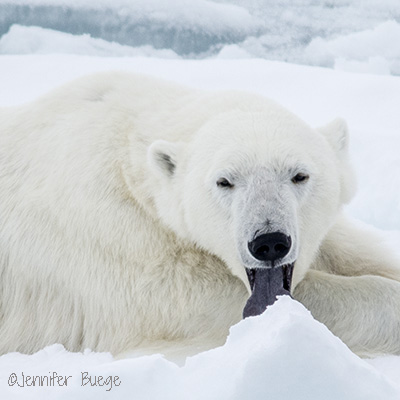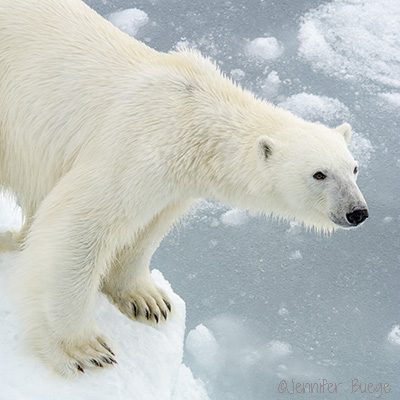
In Search of Polar Bears, Part 1
06-21-2018
On May 31, Ian and I headed out for one of the trips that has topped our bucket list for a while: an Arctic Circle cruise through the waters surrounding Svalbard, Norway.
I’ve wanted to see polar bears in the wild for practically forever. At first, my goal was Churchill in Canada. After talking to the naturalists and photographers on our Galápagos trip, however, we decided to go all in on a trip to Svalbard instead because there we’d have the chance to spot the bears in their natural habitat, on the sea ice. Plus, we’d get to sail through gorgeous landscapes and enjoy other wildlife, like (potentially) walruses, reindeer, foxes, whales and more.
After doing a pretty thorough comparison of the trips available — looking at cost, length of the trip, itinerary, dates — we chose a photography-focused one offered by Quark Expeditions, aptly named: In Search of Polar Bears. The best thing about it was that there was no itinerary; we’d go where the conditions looked the best to fulfill our quest.
It was quite a trek to get to the far north of Norway — our path took us from Minneapolis to Reykjavík to Oslo to Longyearbyen, with a nine-hour layover in the SAS lounge in Oslo — and we arrived at our hotel in Longyearbyen at 2 in the morning. Twelve hours later, we were picked up and taken to the ship, the Ocean Adventurer. It’s a pretty small vessel, accommodating about 130 passengers plus expedition crew and hotel staff (very similar to the Endeavor II that we sailed on the Galápagos). The first day was dedicated to a welcome reception, settling in, getting our parkas and boots, listening to a safety presentation, followed by dinner. Dinner every night would be three courses, and there were plenty of tables to hop among. I was so exhausted that I honestly remember so little from that day, aside from wanting to fall into bed, which we finally got to do.
Our next couple of days were filled with meals, zodiac rides and more meals. The first outing was to Smeerenburg, a settlement on Amsterdam Island. There, we could see the remains of several blubber ovens—ovens housing copper kettles in which whalers would render the fat from their catches, and a phrase that I would get endless enjoyment from. That afternoon, we hop back in the Zodiacs for a cruise around the area of the 14th of July Glacier (named for the French holiday). It’s chilly out but sunny, and the light brings out the varied blue hues of the ice. We’re lucky enough to be with someone who spots an Arctic fox up on the cliffs and watch as it sneaks into the nesting area of some geese and steals an egg. The geese, rightfully, go crazy, but the fox darts off with his prize in his mouth. Happily, we also see a few puffins while cruising. It’s difficult to get good photos — they’re moving and we’re in a bobbing boat — but it’s really cool to watch them zip across the landscape.
That night, to increase our chances of seeing bears, the captain sets a northerly course to try to reach the large ice patches where the bears might still be. That day’s ice chart shows a situation very different from the one exactly a year ago. The ice has broken up and receded farther north, forcing us to cross a large swath of open water and the boat to sway from side to side (relaxing for me, but not for all).
The next morning, we’re at 81 degrees north and ice is everywhere. The expedition team sights a yellowish blur on the horizon, and hopes are raised. The captain skillfully maneuvers us into the ice, approaching the blur. At this point, I can’t even see the blur, but other people can. “Look, it’s there, just past the largish ice block at 12 o’clock.” “Look at where the ice meets the sky, come forward a few inches, and there it is.” Useless. I am the worst spotter ever. But slowly we get closer, and I soon see what looks like a pale banana lying on the ice. We’ve found bear! Everyone is snapping away, using big lenses to bring the bear even closer to us. Then slowly we get closer still. And closer. And closer. Soon the bear is almost within spitting distance, and the crowd goes wild. We contentedly shoot away while the bear sleeps, rolls over, chases a bird, poops and lazes around. After a while, it starts to amble away, heading into the distance where perhaps it will find a seal to munch on.

We are ecstatic. It’s only two days in, and we’ve already seen our quarry — and gotten some cool photos. We head to lunch, satisfied. We load up our plates, find a table and start trading stories of the morning: how we saw the bear, how close we got, the amazing photos we’re sure we have. Then Annie, one of the naturalists, comes on the intercom, her calm voice letting us know that another bear has been spotted and is heading toward the ship. Chaos ensues. En masse, passengers bolt for the doors, leaving barely touched food on the tables as they rush to grab their parks and cameras. We’re no different and race off to our cabin, then head for one of the upper decks.
This time, there’s no need for our boat to move. The polar bear makes good time as he (yes, it’s a he) approaches the ship, sniffing the air and leaping from ice chunk to ice chunk. He’s got a captive audience, too. We have to be quiet so that the bear doesn’t get scoop, and somehow 120 people have managed to stay silent despite the fantastic moment. The bear comes right up to the side of the boat and paws around a little bit. He walks from tip to stern, sniffing the air (later people will hypothesize that he smelled the fish and food in the hold and was looking for a way in) and staring up at us. Talk about being ready for your closeup! This bear did everything short of pose, and I knew that I had captured some once-in-a-lifetime moments.

Finally, the bear became bored or was hungry and wandered off, probably to seek a more promising meal. We headed back to the dining room, overjoyed at the wonderful day, the room burbling over with excitement. We agree that if this were to be the trip, if we didn’t see anything else, it would still be a success. We would end up being quite lucky, however, as the trip continued.
…to be continued…